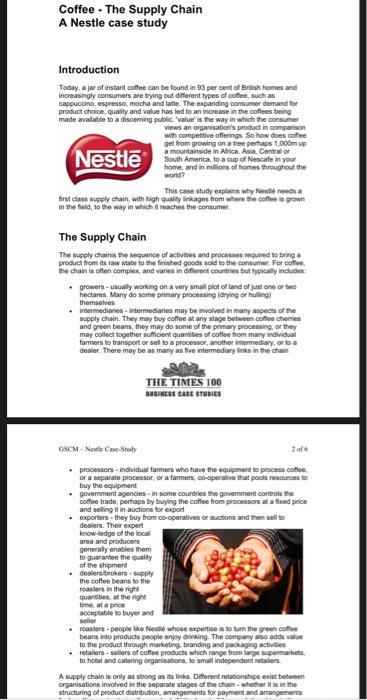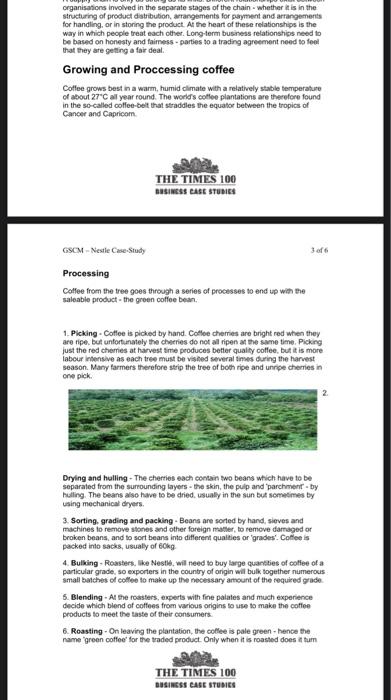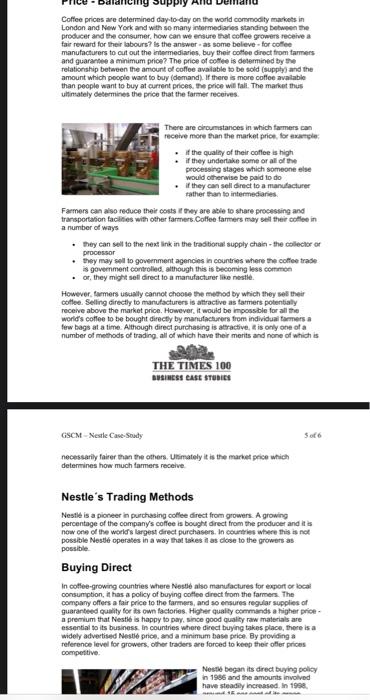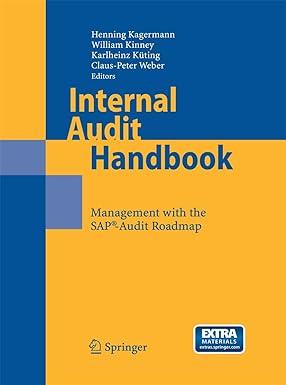Answered step by step
Verified Expert Solution
Question
1 Approved Answer
please read and solve the three questions located in the last page there are a questions at the end of this case study i want
please read and solve the three questions located in the last page 




there are a questions at the end of this case study
Coffee - The Supply Chain A Nestle case study Introduction Today, a jar of instant collee can be found in 93 per cent of Brtish homes and increasingly consumers are trying out diflerent types of coflee, such as cappuocino, espresso, mocha and latle. The expanding consumer demand for product choice, quality and value has led to an increase in the coffees being made avalable to a discering public. 'value' is the way in which the consumer views an organisation's product in comparison wet hom growing on a tree perthaps 1.000m sp. a mountainside in Atrica. Asas, Central or South Amarica, to a cup of Nescale in your homb, and in millione of homes throughout the wcarla? This case study explains why Neste needs a first elass supply chain, with tigh qualty linkages from where the coflee is grown in the field, to the way in which a resches the consumer. The Supply Chain The supply chainis the sequence of activitis and processes requeed to bring a product trom its raw suate to the firished gocets sold to the conaumer. For cothee, the chain is oflen complex, and varies in cifleront courtries but typically induses. - growers - usualy working on a very small plot of tarvd of just one or hwo hectares. Many do sonse primary processing (drying of hulling) themselves - inbermediaries - intermedianies may be involved in many aspects of the supply chain. They may buy coffee at any stage betwoen cotlee cherties and green beans, they may do some of the permary processing. or they may oollect together sumficient quartstes of cotlee from mary individual famers to transport or sel to a processor, another intemsediary, or to a dealer. There may be as many as free intermedary links in the chain THE TIMES 100 aatinest tatt treaits Cisc'M - Nosele Case-Stedy 2 at 6 - processors - individual farmers who have the equipment to process cotlee. or a separate processor, or a farmers. co-operative that pools resoceces to buy the equipment - governmont agencies - in some counbries the government contvols the colfee trade, pertaps by buying the coffee from processons at a fired priot and seling it in auctions for export - axportens - they buy from 00 -operatives or auctions and then sell to dealers. Their expert know ledge of the local area and producern generally enaties them to guarathee the qualty of the shpment - dealersfteokars - supply the coflee beans to the reaslers in the right quanties, af the righe tithe, at a price accoptable is buyer and seller - roasker - people like Nesta whose experise is so hurn the green collee bears inbo products seople enjoy dirking. The coersuany also adds value to the product through mareting, branding and packaging activilies - retailers - sellers of coflee products which range from large supermarkets, to hobel and casering oeganisations, to small independent metallers. A supply chain is only as strong as its links. Diferent relationships enist between crganisations involved in the separate stages of the chain a whether it is in the structuring of product distribution, amangements for payment and arrasgements organisations involved in the separate stages of the chain - whether in is in the structuring of product ditribution, arrangements for poyment and arrangements for handling, or in storing the product. An the heart of these relationships is the way in which people treat each other. Longterm business relationstips need to be based on honesty and fairness - parties 70 a trading agreement need to foel that they are getting a far deal. Growing and Proccessing coffee Collee grows best in a warm, humid climate with a relatively stable temperature of about 27C all year found. The words cotlee plantations are theefore found in the so-called collee-bet that straddles the equator between the tropics of Cancer and Capricom. THE TIMES 100 ansiness east stuace 1. Picking - Cotlee is picked by hand. Colloe chemes are bright red when they are ripe. but unfortunately the chaeries do not all ripen af the sume time. Picking just the red chemes at harvest time produces betler qually collee, but it is more labour insensive as each tree must be vished several timses during the harvest season. Many farmers therefore strip the tree of both ripe and unripe chemies in one pick. Drying and hulling - The cherties each conkain two beans which have to be separated from the surrounding tayers - the skin, the pulp and 'parchment - by huling. The beans also have to be dried. usualy in the sun but scmwermes by using mechanioul dyers. 3. Sorting, grading and packing - Beans are sorted by hand, sieves and machines to remove stones and other foreign mather, to remeve darnaged or broken beans, and to sort beans into diflerent qualties or 'grades'. Cottoe is packed into sacks, usualy of 60kg 4. Bulking - Roasters, like Nestle, will need so buy large quanties of coffee of a particular grade, so exporters in the country of origin will bulk together numerous small batches of colleo to make up the necessary amount of the required gade. 5. Blending - Al the rossters, experts with fine palates and much experience decide which blend of coffees froen various origins to use to make the coffee products to meet the taste of their consumers. 6. Roasting - On leaving the plantation, the coffee is pale green-hence the name 'green coffee' for the traded product. Only when it is roasted does in tum THE. TIMES 100 nasiness cast stumes Coffee prices ave determined day-to-day on the world cormodity markess in London and New York and with so many intermediaries standing bebween the producer and the consumer, how can we ensure that coffee growers recehe a fair reward for their labours? is the answer - as some beleve - for cotlee manufacturers to cut out the intermediaries, buy their ootiee direct from farmers and guarartee a minimum price? The price of cottee is determined by the retationship between the amount of coffee avalable to be sold (supply) and the amount which poople wart to buy (demand). If there is more coffee avalable than people want to buy at current prices, The price wit fall. The market thus ullinately desermines the price that the farmer receives. There are choumstances in which famers can recehe more than the market price. for exartsle: - If the qualify of their colfee is high. - if they undertake some or all of the processing stages which someone else would otherwise be paid to do - If they can sell direct to a mandacture tather than to intermediaries. Farmers can also recuce their costs If they are able to share processing and transportation facilies with other farmers. Collee farmers may sell their botlee in a number of ways - They can soll to the nexs link in the tradibonal supply chais - the colleclor or processor - they may sell to gowernment agencies in countries ahere the colfee trase is govemment combrolied. although this is becoming lass corrimon - or, they might seli direct to a manufacturer like nestle. However, farmers uscdally cannot choose the method by which they sed their collee. Selling directly to manulacturers is attractive as tamers potentialy receive above the market price. However, it would be impossble for all the worlds cotfee to be bought directy by manulacturers from individual farmers a few bags at a time. Although direct purchasing is attractive, th is only one of a number of mechods of trading. all of which have their merits and none of which is THE TIMES 100 Busimess enst stubies GSCM - Neste Cast:Soudy 5 of 6 necessarily faiver than the others. Utimately it is the market grise which determines how much farmers receive. Nestle's Trading Methods Nestle is a pioneer in purchasing coflee direct from growers. A growing percentage of the company's coffee is bought drect from the producer and it is now che of the worid's largest direct purchasers. In courtries where this is nof possible Nestle operates in a way that takes it as close to the growers as possible. Buying Direct In collee-growing countries where Nestie also manufactures for export or local oonsumption, it has a policy of buying ooflee drect trom the farmers. The company offers a fair price to the farmers, and so ensures regular supplies of guaranteed quality for its own faclories. Higher qualify cemmands a higher price a premium that Nestle is happy to pay, since good qualify raw malerials are essential to its business. In countries where direct buying takes place, there is a widely advertised Nerste price. and a minimum base prict. By providing a reference level for growers, other traders are forced to keep their offer prices compertive. Nestue began its drect buying policy in 1906 and the amounts involved have steacily increased. In 1988. Neste began its direct buying policy in 1986 and the amounts invelved have steadily increased. In 1998, around 15 per cent of its green. coffee purchases were bought directly. As an example, in the Philppines, farmers bring their produce to Nestle's buying centres situated in the cottee growing regions. Qualty is analysed while they wat and growers are paid on the spot. In 1998, direct purchases accounted for over 90 per cent of the green coffee destined for its two instant colfee factories in the country. THE TIMES 100 uusiness east stuoits Buying From Dealers In countries like the UK it is simply impossible for companies like Nestle to buy from the hundreds of thousands of farmers who ultimalely supply the corrparyy. and so the coffee is bought feom dealers using the international market. However, Nestle visits and gets to know as many people as possible in the supply chain. The company crersees the relationship between the dealer and exporter and often inviles shippers to the UK to train alongside its own quality assurance statt. Nestle agrees procedures on everything from pest control to methods of packing to ensure everyone is working towards the highest standards of quality. Conclusion Creating wonderful cups of cotfee is not only Neste's business, It is the business of everyone involved in the supply chain. It is in everyone's interest - the farmers' and Neste's - that farmers receive a fair income from their coflee. This ensures that they will continue to grow coffee, and to invest in increasing their yleid and qualty, and this in turn guarantees the supply of euality colfee which companies ike Nestele require. QUESTIONS (1) What aspects of the cotlee supply chain enhance the 'value' that the customer receives in making purchases? (2) Why might it be impractical for Nestle' to make all of its purchases of collee direct from growers? (3) What is the role of intermediaries in the coffee supply chain? What is their impact on price i want to solve them please
Step by Step Solution
There are 3 Steps involved in it
Step: 1

Get Instant Access to Expert-Tailored Solutions
See step-by-step solutions with expert insights and AI powered tools for academic success
Step: 2

Step: 3

Ace Your Homework with AI
Get the answers you need in no time with our AI-driven, step-by-step assistance
Get Started


